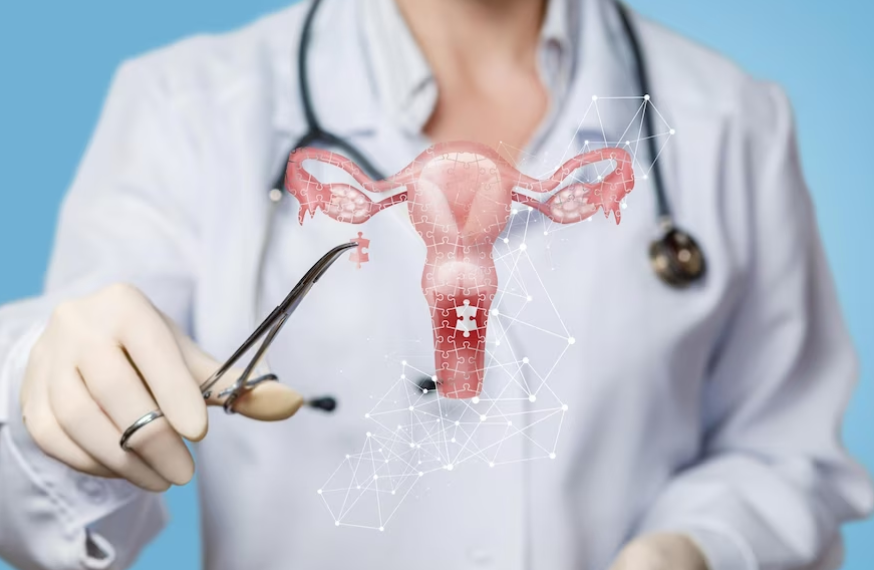
09 Feb Exploring Hysterectomy for Fibroids: Understanding the Procedure and Treatment Options
Hysterectomy, the surgical removal of the uterus, is a common treatment option for women with symptomatic uterine fibroids. In this comprehensive guide, we’ll delve into the intricacies of hysterectomy due to fibroids, including its indications, surgical techniques, and recovery.
Understanding Uterine Fibroids: Uterine fibroids are noncancerous growths that develop in the muscular wall of the uterus. While fibroids may not always cause symptoms, they can lead to various issues such as heavy menstrual bleeding, pelvic pain, pressure on the bladder or bowel, and infertility. When fibroid symptoms significantly impact a woman’s quality of life and other treatment options have been unsuccessful, hysterectomy may be recommended as a definitive solution.
Indications for Hysterectomy for Fibroids:
- Persistent Symptoms: Women experiencing persistent and bothersome symptoms related to fibroids, such as heavy menstrual bleeding, pelvic pain, or pressure symptoms, may opt for hysterectomy when conservative treatments fail to provide adequate relief.
- Size or Number of Fibroids: Large or multiple fibroids may increase the likelihood of symptoms and complications, making hysterectomy a preferred treatment option to address the underlying cause of fibroid-related issues.
- Desire for Definitive Treatment: Hysterectomy offers a permanent solution for women who no longer wish to conceive or have completed their family and are seeking a definitive resolution to fibroid-related symptoms.
Types of Hysterectomy:
- Total Hysterectomy: In a total hysterectomy, the entire uterus, including the cervix, is removed. This procedure is commonly performed for the treatment of uterine fibroids.
- Subtotal (Supracervical) Hysterectomy: In a subtotal hysterectomy, the upper part of the uterus is removed, while the cervix is preserved. This approach may be considered in certain cases, depending on the patient’s preferences and clinical indications.
- Radical Hysterectomy: A radical hysterectomy involves the removal of the uterus, cervix, surrounding tissues, and possibly the upper part of the vagina. This procedure is typically reserved for the treatment of gynecologic cancers and is not commonly performed for benign conditions such as fibroids.
Surgical Techniques for Hysterectomy:
- Laparoscopic Hysterectomy: Laparoscopic hysterectomy is a minimally invasive surgical technique that involves making several small incisions in the abdomen through which specialized instruments and a camera (laparoscope) are inserted. The uterus is then dissected and removed through one of the incisions, resulting in less post-operative pain, shorter hospital stays, and faster recovery times compared to traditional open surgery.
- Robotic-Assisted Hysterectomy: Robotic-assisted hysterectomy is a variation of laparoscopic surgery that utilizes robotic arms controlled by the surgeon to perform the procedure with enhanced precision and dexterity. This approach offers similar benefits to laparoscopic hysterectomy and may be preferred in certain cases, particularly for complex or difficult-to-reach fibroids.
- Vaginal Hysterectomy: Vaginal hysterectomy involves the removal of the uterus through the vagina, without the need for external incisions. This approach may be suitable for women with smaller fibroids and favorable pelvic anatomy, offering the advantages of reduced post-operative pain and faster recovery.
Recovery After Hysterectomy: The recovery period following hysterectomy varies depending on the surgical technique used and individual patient factors. In general, women undergoing laparoscopic or robotic-assisted hysterectomy experience shorter hospital stays, less post-operative pain, and faster return to normal activities compared to open surgery. Patients are typically advised to avoid heavy lifting and strenuous activities for several weeks after surgery and may require pain medication and pelvic rest during the initial recovery period.
In Conclusion: Hysterectomy remains a viable treatment option for women with symptomatic uterine fibroids who desire definitive relief from their symptoms. With advancements in surgical techniques, such as laparoscopic and robotic-assisted hysterectomy, women can undergo this procedure with reduced post-operative pain, shorter hospital stays, and faster recovery times. By consulting with experienced specialists , like Dr. Usha M Kumar, one of the leading specialists in laparoscopic hysterectomy in South Delhi, women can receive comprehensive evaluation and personalized treatment for fibroids, ensuring optimal outcomes and improved quality of life.




Sorry, the comment form is closed at this time.